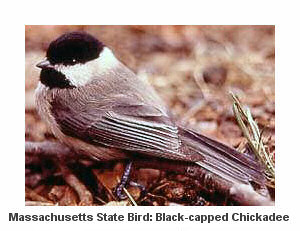Massachusetts State Bird
| Chickadee |
Penthestes atricapillus |
Adopted:1941 |
Adoption of the Massachusetts State Bird
The Executive Board of the State Federation of Women's Clubs adopted the veery (Hylocichla fuscescens),
a secretive thrush with a beautiful song, for their Massachusetts state bird in November 1931. A bill to designate
the veery the official state bird was introduced in the legislature in the same year. It was not approved.
Almost ten years later, on March 21, 1941, the Massachusetts Legislature took up the question of a state bird and
decided to make the chickadee (Penthestes atricapillus) the bird or bird emblem of the commonwealth.
About the Massachusetts State Bird
Habitat:
Black-capped chickadees nest throughout southern Canada and the northern half of the United States. In Missouri, the black-capped chickadee generally nests north of the Missouri River and the Carolina chickadee nests south of the River. The breeding range extends farther south at higher elevations of the Rocky and Appalachian Mountain ranges than in non-mountainous areas. In Colorado, black-caps are most abundant in the ponderosa pine and aspen forests (Bailey and Niedrach 1965).
Nest:
Chickadees nest in cavities but roost anywhere convenient, generally not in cavities (Odum 1942). The most suitable nesting sites are stubs with partially decayed cores and firm shells. They usually excavate their own cavities, but will use natural cavities or nest boxes. Black-caps will occasionally nest in a cavity they used the previous year after making some alterations. Preferred nesting sites throughout the eastern forests are tree species that occur in the early seral stages but that are short lived and persist in the intermediate stages as decaying stubs (Odum 1941, Brewer 1961).
Food:
The diet of the black-capped chickadee is comprised of 70 percent animal and 30 percent vegetable matter. Mast, chiefly from coniferous trees, and fruits of bayberry, blackberry, blueberry, and poison ivy make up the bulk of the vegetable matter. Animal material eaten (mostly insects) includes caterpillars, eggs, moths, spiders, and beetles. Winter diet is primarily larvae, eggs, katydids, and spiders (Bent 1946, Martin et al. 1951).
General Laws of Massachusetts
The following information is excerpted from the General Laws of Massachusetts,
Chapter 2, Section 9.
PART I. ADMINISTRATION OF THE GOVERNMENT.
TITLE I. JURISDICTION AND EMBLEMS OF THE COMMONWEALTH, THE GENERAL COURT, STATUTES AND PUBLIC DOCUMENTS.
CHAPTER 2. ARMS, GREAT SEAL AND OTHER EMBLEMS OF THE COMMONWEALTH.
SECTION 9.
Chapter 2: Section 9 Bird or bird emblem of commonwealth
Section 9. The chickadee (Penthestes atricapillus) shall be the bird or bird emblem of the commonwealth
Additional Information
Poecile atricapillus (Black-capped Chickadee):
University of Michigan Museum of Zoology: Animal Diversity Web.
State Bird List:
List of all of the state birds.
Birds of Massachusetts: Field Guide:
by Stan Tekiela.
State Birds & Flowers 1000-pc Puzzle:
Created at the request of The National Wildlife Federation this design is a beautiful and informative puzzle featuring every state bird perched on the appropriate state flower.
Bird Feeders and Accessories:
Backyard Birding > Bird Feeders & Accessories from Amazon.com.
State Names, Seals, Flags, and Symbols:
A Historical Guide, Third Edition - Benjamin F. Shearer and Barbara S. Shearer, Greenwood Press, 2002
State Names, Flags, Seals, Songs, Birds, Flowers and Other Symbols:
A Study based on historical documents giving the origin and significance of the state names, nicknames, mottoes, seals,
flowers, birds, songs, and descriptive comments on the capitol buildings and on some of the leading state histories,
Revised Edition - George Earlie Shankle, Ph.D., The H.W. Wilson Company, 1938 (Reprint Services Corp. 1971)
Source: General Laws of Massachusetts, (https://malegislature.gov//laws/mgl/mgllink.htm), April 10, 2005
Source: State Names, Seals, Flags, and Symbols: A Historical Guide, Third Edition - Benjamin F. Shearer and Barbara S. Shearer, Greenwood Press, 2002
Source: State Names, Flags, Seals, Songs, Birds, Flowers and Other Symbols: Revised Edition (Reprint)- George Earlie Shankle, Ph.D., The H.W. Wilson Company, 1938 |


